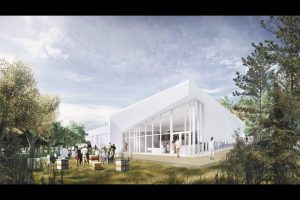New Honey Bee Research Centre creating a buzz at Univ. of Guelph
Set to break ground this summer, the new Honey Bee Research Centre on Stone Road will be a state-of-the-art research and education/outreach destination
 A new facility for honey bee research, education, advocacy and outreach is coming to the University of Guelph.
A new facility for honey bee research, education, advocacy and outreach is coming to the University of Guelph.
Set to break ground this summer, the new $16.1-million Honey Bee Research Centre (HBRC) will be a state-of-the-art research and education/outreach destination dedicated to all aspects of honey bee health and well-being.
The new HBRC will be located on a former U of G physical resources tree nursery, east of the main campus near the corner of Stone Road East and Victoria Road. Work is currently underway clearing the property.
The current version of the Honey Bee Research Centre is at Townsend House which is a 1960’s bungalow on Stone Road East.
“They’ve outgrown that facility a long time ago,” said John Cranfield, associate dean for external relations at the University of Guelph’s Agricultural College.
The completion of the new Honey Bee Research Centre is projected for fall 2024.
Cranfield said the aim is to have a ground-breaking celebration in June, to not only thank people who have shown their support, but to raise awareness and attention to the project.
“We are really excited about the project and what it can do to raise awareness for the role of pollinators as well as what we are doing at the University of Guelph to make sure that we are addressing pollinator health, wild and managed, because we do both here at our college,” Cranfield said.
With a significant increase in honey bee colony mortality over the last decade, research is becoming increasingly important.
Honey bees are necessary for 1/3 of the food that humans consume. HBRC’S mandate is to support the future of honey bees through research, teaching and outreach.
“There’s one thread that weaves all of humanity together throughout all of time, and that is ‘what we eat.’ We all have to eat, and we know that pollinators of all kinds play an important role in the production of food,” Cranfield said.
“We have a long history. We’ve had a honey bee research centre and apiary since 1894. So, we are well versed on it and that is why we are really excited about this amazing facility.
“Our Honey Bee Research Centre is recognized globally for the science that comes out of the centre and the outreach that happens. There’s the scientific discovery that is fundamental to improving bee health, but there’s also the outreach that makes that research tangible for bee keepers,” Cranfield said
“It’s about putting that knowledge into action and into the hands of bee keepers.”
In addition to a 100 hive apiary, the new HBRC will be a 15,000 sq.ft facility that includes space for research, production and outreach programs, a research laboratory, as well as office and classroom space.
It will also serve as a demonstration facility for best practices in commercial beekeeping and honey production, enable world class research on honey bee health, and act as a vehicle for increased community outreach and public education.
Cranfield said that a very large part of the building will be public-facing.
“We are calling that the discovery centre, and that is the outreach component,” Cranfield said.
“We’ve designed the facility so that we can host school groups and other social functions. There’s a range of different options that can be housed at that facility, and right now, we don’t have that at Townsend House, at least not on the scale that we need.”
The University of Guelph has the largest research apiary in North America, he noted.
“The new centre will offer a dedicated space for learning. It’s a great way to help young people put STEM into action, in helping them understand the important role of pollinators.”
In terms of accessibility, the centre will be near a bus and bike route, surrounded by pollinator gardens and walking trails.
“There are wetlands all around us. What is really key is that there are nearby sources of pollen throughout the year, so when trees are beginning to leaf in the spring, that is an important source for pollinators. Throughout the summer, natural and planted flower beds are important. So, when bees wake up from winter, will have access to pollen and access to the environment which is important for what they do,” Cranfield said.
Located adjacent to the arboretum, Cranfield said this will help create a flow of people between two functional areas of the university.
“Visitors from the arboretum can also discover what we do at the Honey Bee Research Centre,” Cranfield said.
“This is great in making sure that we are all working together to activate that part of the campus and further enhance how we can engage with the public around nature, around pollinators, and around what we are doing at the university to help support both.”
So far, the project has raised $13.38 million towards a $16.1-million goal.
We are here to share current happenings in the bee industry. Bee Culture gathers and shares articles published by outside sources. For more information about this specific article, please visit the original publish source: New Honey Bee Research Centre creating a buzz at U of G – Guelph News (guelphtoday.com)






